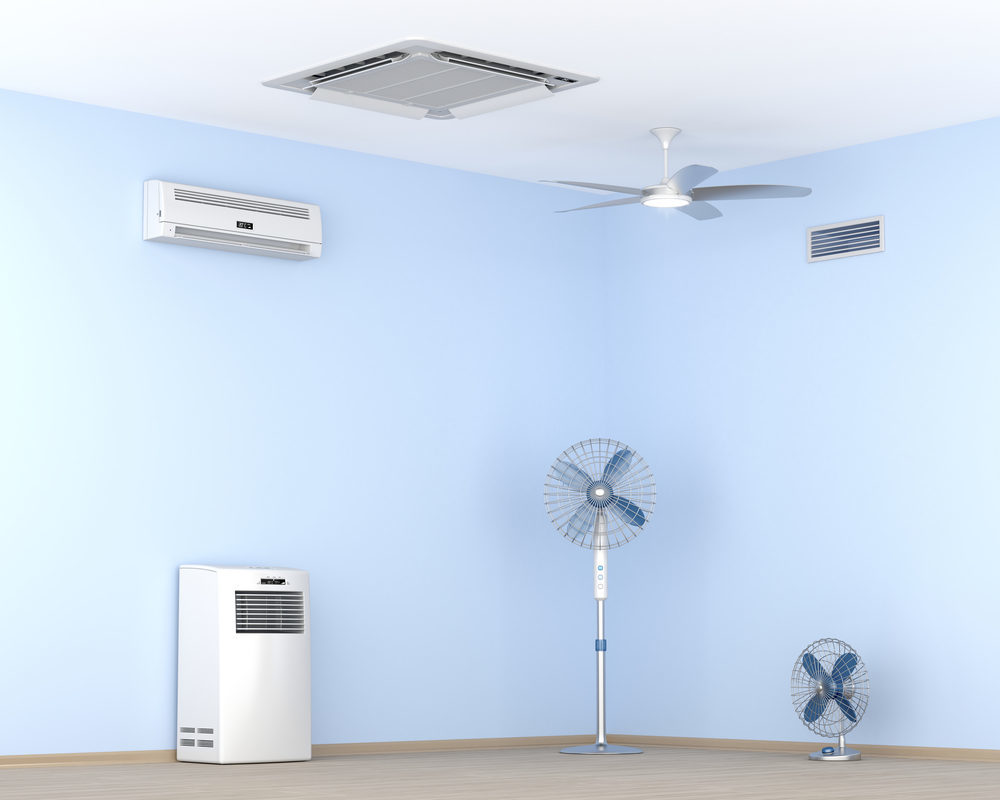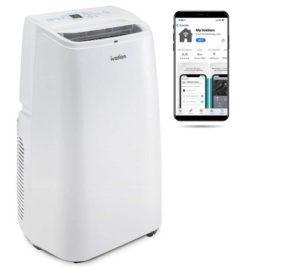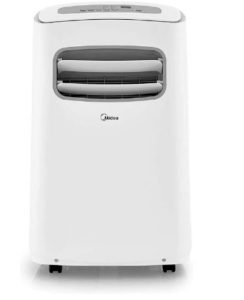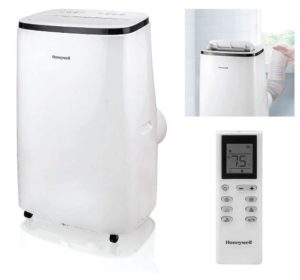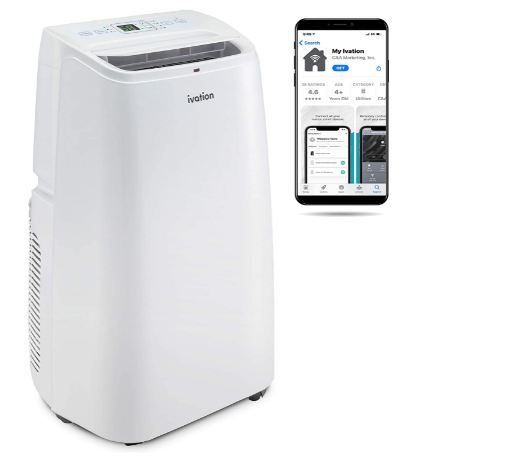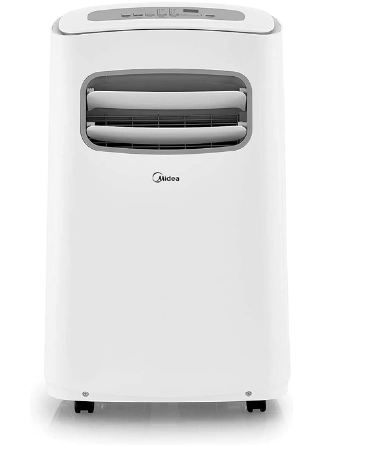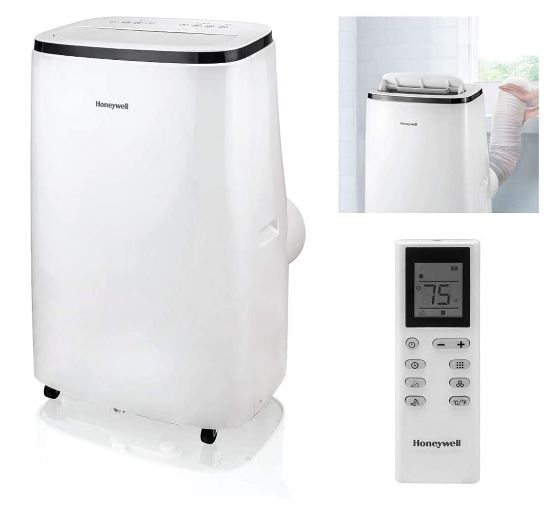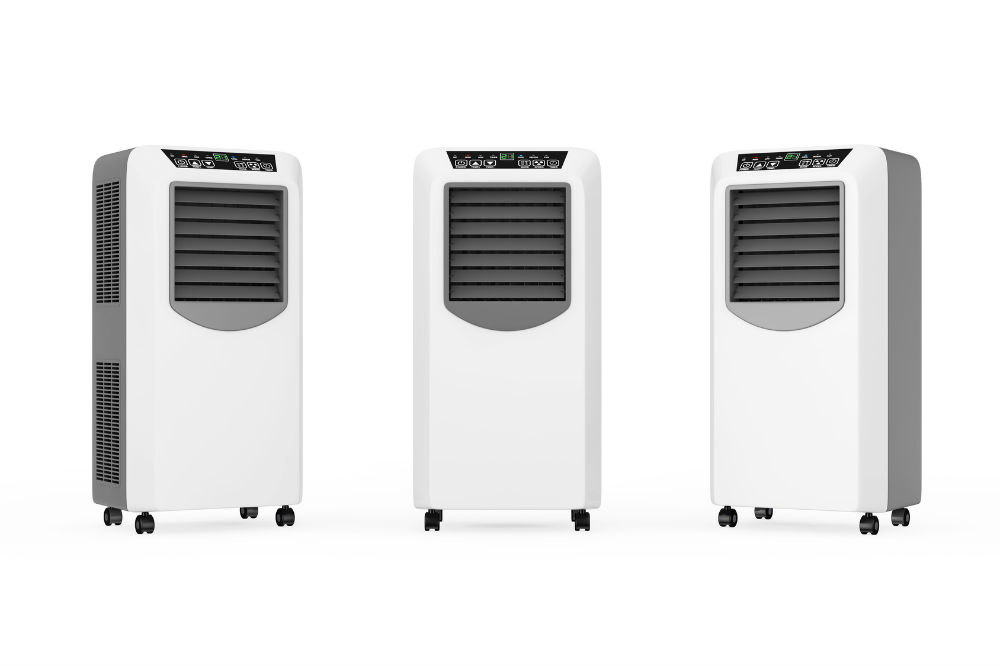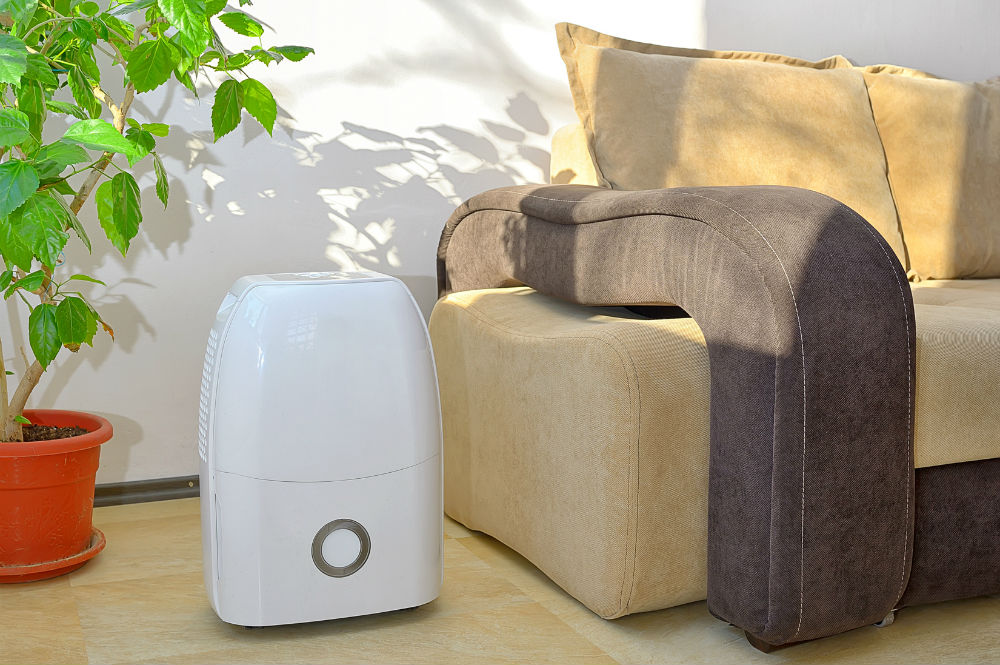Shopping for a Stand-Alone Portable AC?
Have a look at our list of recommendations below.
Not every homeowner needs the same kind of AC –many of us are happy relying on central air conditioning to keep our entire house cool.
In contrast, others use window air conditioners to maintain colder temperatures in specific rooms.
While these are the two most common types of air conditioning, another type is also gaining popularity – stand-alone (portable) air conditioners.
This article reviews some of the best standalone air conditioners sold today and recommends top picks for specific needs.
Who Should buy a Stand Alone Air Conditioner?
Whether you have to endure hot weather for a few months or year-round, a stand-alone AC will keep you from becoming hot and sticky.
Unlike a window AC, you can move a standalone AC from room to room so you can enjoy cool air throughout the house without spending a fortune on energy bills.
Renters
Because they don’t require permanent installation, portable air conditioners are a popular choice with renters.
Unlike window ACs, they don’t block a window nor require installation that a landlord may not like.
All they need is a small space for venting out hot air and, in some cases, access to a drain line for expelling condensate.
Students
We all know how small a college dorm can be.
If a dorm lackscentral climate control or just doesn’t do the job, most students cannot install a window air conditioner to fix it.
To remedy the situation, they can invest in an affordable portable air conditioner to maintain a comfortable environment.
Rooms With Non-Standard Windows
While they are certainly more powerful, window AC units require a standard fit window for installation.
Because of the diversity in construction, not every building uses standard window sizes.
No Central AC
A stand-alone AC is a great option for homeowners who live in mostly mild climates that don’t see a lot of hot weather and typically do not require central HVAC systems.
Offices & Server Rooms
Many older corporate buildings house server rooms and use computers that their AC systems just weren’t design to cool.
A stand-alone air conditioner is a great second option for the warmer parts of the floor – or when the building turns the central AC off.
Our Top 3 Picks
- Can be controlled over Wi-Fi with the My Ivation app
- The powerful unit offers effective cooling, dehumidifying, and air circulation
- Omni-directional wheels and built-in carry handles increase portability
- It supports a single-hose configuration
- Supplied with an adjustable window bracket
- Supports remote control and voice-command operation
- Designed to cool spaces up to 700 Sq ft
- Smooth gliding castor wheels
- Removes 90 pints per day
What's in This Buying Guide
Table of Contents
This buying guide includes everything you need to know to purchase the best standalone AC unit.
We also describe the important factors to look out when selecting the best standalone air conditioner for your needs.
Lastly, we answer some FAQs about these units.
So let’s dive in:
Best Stand Alone Air Conditioners
- 1. Best Smart Stand Alone AC: Ivation Portable AC with Wi-Fi
- 2. Best for Small Rooms: Midea MAP10S1CWT
- 3. Best for Large Rooms: Honeywell HJ4CESWK9
Disclaimer: All links below go to Amazon.com
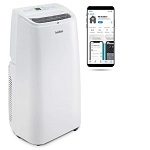
Ivation Portable AC with Wi-Fi
Best Smart Stand Alone AC
Dimensions:
20.51 x 14.17 x 28.74 inches61lbs
12,000 BTU
Up to 450 Sq Ft
Single Hose
Modes
Cool, Dry, Fan1 Year warranty
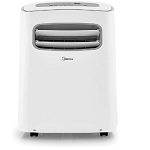
Midea MAP10S1CWT
Best for Small Rooms
Dimensions:
17.1 x 13 x 28.3 inches68lbs
10,000 BTU
Up to 200 Sq Ft
Single Hose
Modes
Cool, Dry, Fan, Sleep1-yearWarranty
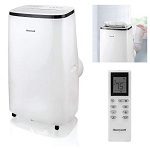
Honeywell HJ4CESWK9
Best for Large Rooms
Dimensions:
18.9 x 15.4 x 30.7 inches69 lbs
14,000 BTU
up to 700 Sq ft
Single Hose
Modes
Cool, Dry, Fan, Auto, Sleep1-yearWarranty
In today’s era of smart homes, Ivation came up with a device that upped the portable AC game.
The Ivation Portable AC with Wi-Fi is an advanced stand aloneair conditioner you can control with your smartphone.
It is great for cooling small to medium spaces, making it a great choice for most buyers.
PROS
- Versatile unit and easy to set up
- Compact size does not take up too much space
- My Ivation app is super easy to use
- Comes with a full feature remote
- The hose can extend up to 59 inches
CONS
- Wi-Fi takes some time to connect
- Lacks dual-hose configuration
Features
- Can be controlled over Wi-Fi with the My Ivation app
- The powerful unit offers effective cooling, dehumidifying, and air circulation
- Omni-directional wheels and built-in carry handles increase portability
- Features an easy-to-read display and remote control operation
- You can operate it at three different speeds
Our Review
This top rated portable air conditioner provides you with a refreshing and simple way to cool your room with its Wi-Fi connectivity.
It can connect to your smartphone over Wi-Fi, and you can use the My Ivation app to control it. The app grants you access to all its features, including modes, fan speeds, and timer, and is very simple to use.
It is a compact yet heavy-duty unit and comes with a window kit that makes it very easy to vent out. With its single-hose configuration, the device easily maintains a comfortable indoor environment in the room you use it.
The Ivation AC is one of the most versatile options currently available. You can choose between three different operational modes – cooling, drying, and air circulation.
The cooling mode is the air conditioning mode that lowers the temperature of the room. The drying mode is the dehumidifier mode that removes the extra moisture from the air. While the air circulation mode is fan mode which merely circulates the air around the room.
There are three ways to control this remarkable AC.
The first is the onboard LCD that lets you switch it on, adjust the settings, and view the current temperature and Wi-Fi connectivity status. The second is the full-feature remote control that enables you to configure the unit more conveniently. Lastly, you can also use the My Ivation app to control the unit.
Midea is a reliable name in the air conditioner market, and this list would be incomplete without the MAP10S1CWT. It is a compact powerful unit that is especially suited for small rooms.
PROS
- Features a sleek and stylish look
- Supports Amazon Alexa and Google Assistant connectivity
- Wi-Fi enabled
- The five-feet long hose adds flexibility
- A four-wheeled unit is easy to move from one room to another
CONS
- One of the noisier units out there
- Draining the unit is a difficult process
Features
- It supports a single-hose configuration
- Supplied with an adjustable window bracket
- Supports remote control and voice-command operation
- Equipped with a washable and reusable filter
- Sleep mode ensures a peaceful night’s sleep
Our Review
The Midea MAP10S1CWT is a top rated portable air conditioner. It features a sleek and stylish design that won’t look out in any modern or contemporary decor.
The four-wheeled device is easy to move from one place to another and comes with an adjustable window bracket for both horizontal and vertical installation.
A good thing about this air conditioner is its Wi-Fi connectivity. You can hook it up to your home network and pair it with Alexa or Google Assistant to control it with voice commands.
Or you can also operate it with the compatible app to switch modes or set a schedule, among other things.
The device itself features a control panel with an easy-to-read digital readout on the top. It includes digital controls for power, temperature adjustment, mode, timer, swing, sleep mode, and LED indicators for Wi-Fi and filter change.
It also comes with a remote control so you can adjust the settings without having to get up.
Just like the majority of portable ACs out there, the Midea MAP10S1CWT also supports three operating modes.: cooling, dehumidifying, and fan. Yet, it stands out from the rest with its sleep mode.
When you turn the sleep mode on, the device automatically regulates the room temperature so you don’t feel cold during the night.
The Honeywell HJ4CESWK9 is one of Honeywell’s best portable air conditioners. This compact unit is designed to cool largerrooms with powerful performance and long list of features.
PROS
- Boasts an eye-catching appearance
- Features a full-function remote control with an LCD
- Top-loaded control panel with digital LED display and feather touch controls
- One of the quietest air conditioners in its class
- Auto-evaporative system takes care of the accumulated water
CONS
- No Wi-Fi connectivity
- The compressor is quite noisy
Features
- Designed to cool spaces up to 700 Sq ft
- Smooth gliding castor wheels
- Removes 90 pints per day
- Quick and easy installation (parts included)
- Dual washable filters
Our Review
With 14,000 BTUs of cooling output, the Honeywell HJ4CESWK9 is one of the most powerful portable and top rated portable air conditioners currently available on the market. It features a single-hose design yet efficiently cools large areas in no time.
It is suited for rooms up to 700 square feet. You can use it to cool down one large room or even 2-3 rooms if you allow for ample airflow between them. It offers three modes to choose from: cooling, drying mode, and fan mode.
It is one of the quietest units out there and generates about 52 dB of sound. Still, the noise of the compressor can quickly irritate you. The solution to this problem lies in its remote control operation. You can set the unit up in a convenient place and use the remote to control it from afar.
Other noteworthy features include smooth-gliding caster wheels, three fan speeds, dual washable, reusable filters, and a dehumidification capacity of up to 90 pints.
Although this is a self-evaporative unit, it comes with a continuous drain system to expel water collected while using the dehumidification mode.
Stand Alone Air Conditioners: Buying Guide
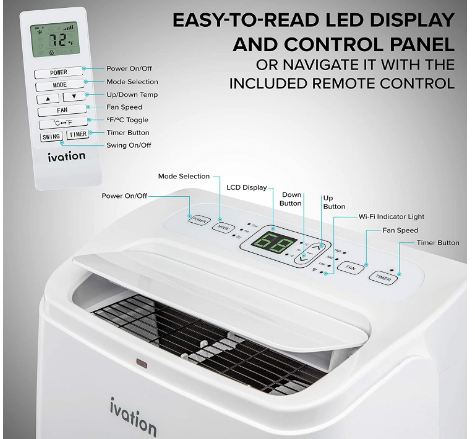
What are Stand-Alone Air Conditioners, and How do they Work?
Stand-alone or portable air conditioners are self-contained air cooling devices. Unlike their central or window-mounted counterparts, they do not require any permanent installation. They sit on the floor and are powerful enough to cool any one room.
Their most significant advantage over other AC types is their portability – they are compact and ensure easy mobility.
These mobile ACs usually come with wheels and handles for easier movement between rooms. And, since they don’t require fixed installation, you can use them anywhere inside the house.
A good thing about these versatile units is their ease of setup. Although they don’t require any permanent installation, some units come with a window kit that creates an air-tight opening for the exhaust hose. Others don’t need to be hooked up but work best in a well-ventilated area.
Just like their window-mounted variation, stand-alone ACs work by pulling hot air from the room inside the unit. Once inside, the air passes over condenser coils that cool it down. The process also condenses the extra airborne moisture on the coils as water.
The cool air is then blown out into the room via outlet vents. Throughout the entire process, the system generates heat that must be vented out. For this reason, these units come with an exhaust hose.
The water collected from the air is disposed of either by self-evaporation or by draining.
Self-evaporative devices use the system’s heat to evaporate water and vent it out the exhaust hose along with the hot air.
Draining units either use a hose to drain the water out of the system or collect it inside a built-in reservoir that you have to empty later.
Types of Portable ACs
One essential step in the working of a stand-alone air conditioner is venting out hot air. For this purpose, mobile ACs either have one or two exhaust hoses at the back.
Based on the hose configuration, portable ACs are categorized into single-hose and dual-hose units. Then there is another type of portable ACs, too – evaporative units.
Single Hose
These stand-alone air conditioners rely on a single hose to intake air from the outside to cool the components and exhaust hot air. While they effectively cool the room, you are using them in, they have to work hard to do so. Hence, they consume more energy.
However, they are more affordable and less space-consuming, making them great for small areas.
Dual Hose
Such stand-alone ACs have two hoses sticking out their back. Their design is such that one hose brings in air from the outside to cool the compressor and condenser coils—meanwhile, the other exhausts out the heat generated by the system.
Because of their dual-hose configuration, these units are quite energy-efficient. They are also quicker at cooling than single-hose units and are suitable for larger areas.
Evaporative
Unlike their hosed counterparts, evaporative portable ACs are completely free-standing. They don’t need a hose to vent out hot air.
Instead, they evaporate the accumulated moisture and use it to cool down the coils and the compressor. Hence, there is hardly any water or heat left to exhaust. So, they are the most convenient portable AC models to own because of the little maintenance involved.
Why buy Stand Alone Air Conditioners Over Other Kinds

A stand-alone air conditioner has numerous advantages over other kinds of air conditioners. Here’s how these units compare with window-mounted, whole house, and evaporative ACs:
Stand-alone vs. window-mounted
Stand-alone ACs stand superior to window-mounted counterparts because of their portability and versatility. They don’t need a dedicated window for installation; instead, you can place them anywhere in the room.
You can also conveniently move them from one room to another. Plus, because of their compact size, they don’t take as much space. The window kits accompanying them also don’t block the entire window, so you get to enjoy an unobstructed view, too.
There is also no risk of them falling out of the window, so most home associations don’t object to them as many do on window ACs.
Stand-alone vs. whole-house
As compared to stand-alone ACs, a central air conditioning system is quite large and space-consuming. It requires permanent installation, that too, by professionals. It has a higher upfront cost and is also expensive to run.
And even with a central AC installed, there is room for a portable unit. It can supplement the system by cooling rooms that the system doesn’t adequately serve. Or you can use it to cool the room you are in.
Stand-alone ACs vs. Evaporative coolers
Dubbed as mini air conditioners or personal air conditioners, evaporative coolers are also popular among buyers.
However, where portable ACs remove moisture from the air, evaporative coolers add more. They also don’t do anything to remove heat from the room; instead, they only blow cold air in one or two directions.
What to look for When Buying a Stand-Alone Air Conditioner
Portable ACs were an instant hit for their energy efficiency, versatile operation, and portability. Many manufacturers jumped to the opportunity and launched their own models, resulting in a plethora of options to choose from. However, not all of them are created the same.
So to make sure you purchase the best portable AC unit, you have to be mindful of the following few aspects:
Evaporative or non-evaporative
Stand-alone ACs are also categorized upon their evaporative and non-evaporative functionality.
Non-evaporative units rely on a single or dual hose to pump out the heat generated by the system. On the other hand, evaporative units rely on the water extracted from the air. They evaporate it and use it to cool down the components; hence there is no heat to exhaust out.
If you want a free-standing, low-maintenance unit, you should go for an evaporative model.
Room size
Most portable air conditioners fail to cool an area because they are used in inadequately sized rooms. What many people don’t realize is that you can’t use your portable AC to cool a room of any size.
Each unit is configured to cool a room of a specific size. So, you should also look for a unit that can cover the area of the room you plan to use it in. And if you are planning to use it all over the house, go for a unit that can cool the largest room of your home.
Manufacturers list the coverage area of each unit so you can easily pick out a suitable one.
Drainage
Just like a traditional air conditioner, a portable air conditioner also removes extra moisture from the air. The moisture condenses on the cooling coils from where it is drained out of the system.
Now, you might want to consider the drainage options because some units collect the water in a built-in reservoir while others expel it out via a hose using gravitational force.
With the former, you will need to empty the reservoir regularly to prevent it from overfilling. While, for the latter, you have to think about the hose set up for draining the water directly down a drain.
When it comes to units that use a hose, you can also install a condensate pump to direct the water upwards towards a sink or a window for expulsion.
Power Consumption
Although stand-alone AC units are quite efficient, you might still want to consider the device’s power consumption you choose. The simpler the device you choose, the less power it will consume.
Keep in mind that all the fancy features like Wi-Fi connectivity will also cause your unit to consume more power. It’s best to stick to your budget and choose a model whose running costs are not too high.
Cost and Warranty
The cost of a portable AC includes both the upfront cost of the unit itself and the running cost.
The key to finding a reliable unit is to look for a cost-effective model that is not too hard on your pocket and doesn’t result in high energy bills too. However, that is easier said than done. So, the best you can do is find the most energy-efficient model that falls within your budget.
You will also have to spend some money for maintenance, but since stand-alone ACs are usually quite low-maintenance, you won’t be hard-pressed for them.
The warranty coverage is also essential to consider when purchasing a portable air conditioner for yourself. If you want to know how reliable a unit is, check its warranty. Manufacturers confident about their units usually back them up with long comprehensive warranties.
It’s always a good idea to steer clear away from units with short or no warranty because if they malfunction, you’ll have to pay for repairs from your own pocket.
Pros and Cons

Before you go on and finalize your purchase of a suitable stand-alone AC, here is a brief account of some of their pros and cons:
Pros
Don’t require installation
The best thing about stand-alone air conditioners is that they don’t require any installation. They come pre-assembled, and you only need to set them up in a suitable spot.
While you might struggle with the provided window kit for the first few times, with practice, it won’t take long to install it. This saves you from the hassle of calling over a technician and having him drill holes in the walls to install your AC.
Easy to move from one room to another
Another good thing about these devices is their portability. They are compact and often equipped with handles and wheels for easier movement.
You can place them in the bedroom during the night and put them in the lounge during the day. Hence, there is no need to call a technician whenever you want to place your AC in a new room.
More affordable
Earlier, there used to be a considerable price margin between portable ACs and their window-mounted counterparts. Today, portable ACs have become more affordable.
Even the most compact and budget-friendly devices these days are powerful enough to cool a large area, given that you use one with appropriate area coverage.
Can be stored away when not needed
Stand-alone ACs can be put away or hidden out of sight when they are not needed.
If you feel that your unit is ruining the look of your interior, you can move it away and place it on a spot where it looks better. Similarly, during the winter days, when it is not needed, you can store it away to free some floor space.
Cons
Noisy
The biggest drawback of portable ACs is their noise. Unlike other types of air conditioners, stand-alone ACs don’t have an outdoor unit hence the entire cooling procedure takes place inside their compact body.
Because both the fan and compressor have a noisy operation, these ACs tend to emit significant noise. If you are a light sleeper or are easily irritated by noise, they are not the right choice for you.
Some models require regular draining
This con is particular to non-evaporative units only. As they cool the air, airborne moisture condenses onto the coils as water.
Unless you set up a hose for draining it, the water will accumulate in the reservoir built into the unit. If you don’t empty it regularly, the water will overflow and create a mess for you to clean.
Frequently Asked Questions
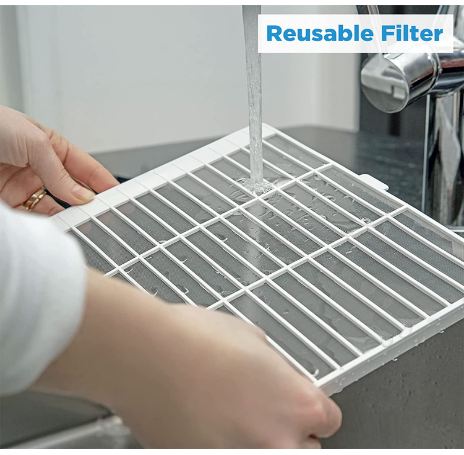
Do portable air conditioners work as good as window units?
Truth be told, window units have a reputation for being quieter and more effective at cooling than portable units. However, they are bulkier and are fixed in one place.
On the other, portable units are, well, portable. They don’t require any permanent installation and can be moved from one place to another. They are also very effective if you choose the correct size.
Can I use a portable AC without venting?
No, you cannot use your portable AC without venting it out. Much like traditional ACs, portable air conditioners also pull in warm air from the room, cool it, and blow it back out the front.
The entire process generates heat that needs venting out. This is why you should always use your stand-alone AC with some sort of venting in place.
What do you mean by BTUs?
British Thermal Unit or BTU is a unit of thermal measurement. In the air conditioner world, it is used to denote an AC’s cooling capacity. The higher the BTU rating, the more powerful the unit and the more area it can cover.
What does SAAC mean?
SAAC stands for Seasonally Adjusted Cooling Capacity. It is the measurement of the weighted average performance of a portable AC under various test conditions.
Measured in BTUs per hour, it was introduced to eliminate inconsistent testing that resulted in misleading Energy Guide labels. It is a new federal test standard established by the Department of Energy that the latest productions of stand-alone units must follow.
Final Verdict: What is the best Stand Alone Air Conditioner?
All in all, we find the Ivation Portable AC with Wi-Fi to be the best portable air conditioner. It is a smart and powerful unit with all the right features and a great area coverage.
But if you are looking to cool a smaller room, we recommend you go for the Midea MAP10S1CWT. It is a stylish and affordable unit with an area coverage suitable for small spaces.
And if you want a large portable air conditioning unit, choose the Honeywell HJ4CESWK9. Given its impressive and unique features, it is one of the best portable air conditioners for big spaces.
I’m a degreed ME (mechanical engineer) who is passionate about machines of all kinds. I created MachineWonders.com as a way to connect with others who love machines like me – or need help choosing one for their needs, application, or situation.

